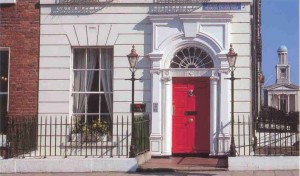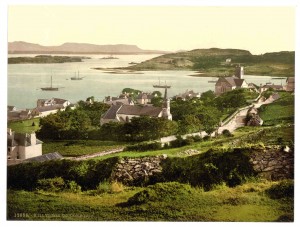In Search of Ireland ISBN 0413548503 was re-issued by Methuen in 2000
Rating: 




A Fleet Street reporter, H. V. Morton (1892-1979) fought in the First World War and was in Egypt in 1922 at the opening of Tutankhamun’s tomb. One of the century’s most popular travel writers, he wrote books about Spain, Italy and the Middle East as well as the famous ‘In search of..’ series on the British Isles.
Something to remember about Morton’s book on Ireland is its historical perspective. In Search of Ireland was first published in 1930, which was a few years after Ireland had become a Free State in 1922. Morton is seeing Ireland in the early stages of independence separated from Britain. He warns the English in his introduction, “We must forget the hosts of prejudiced ideas about her which have accumulated during centuries of strife and misunderstanding…I must stress the point that the new generation of travellers must approach Ireland with the feeling that it is a foreign country.” I could not help but reflect on the history he refers to, when England was so often the aggressor, and Ireland the betrayed. Sometimes it seems he relates the events connected with a place without examining the underlying issues, he observes the empty cottages with hardly a mention of the famine or the forced evictions, or that emigration was so often not a choice, but a matter of survival. Nonetheless, Morton’s humorous and insightful observations about Ireland, as a traveller in a foreign land, are worth reading and re-reading.
“Dublin in the early morning, with the sun shining, is a city the colour of claret. The red-brick Georgian mansions, with fine doors, fanlights, and little iron balconies at the first-floor windows, stand back in well-bred reticence against wide roads, quiet and dignified, as if the family has just left by stagecoach.” Prose of this quality is what raises travel writing to literature, and Morton’s skill as an evocative writer is worthy of the best of his era. In explaining about the Book of Kells, which is kept in Trinity College, Dublin, he says that during the three darkest centuries of English history it was Ireland that was saving Greek and Latin for Europe..
windows, stand back in well-bred reticence against wide roads, quiet and dignified, as if the family has just left by stagecoach.” Prose of this quality is what raises travel writing to literature, and Morton’s skill as an evocative writer is worthy of the best of his era. In explaining about the Book of Kells, which is kept in Trinity College, Dublin, he says that during the three darkest centuries of English history it was Ireland that was saving Greek and Latin for Europe..
He writes, “An unknown Irish monk, probably one of the world’s greatest artists, was writing the Gospels in an abbey at Kells in County Meath, founded by St. Columba.. and in that Golden Age of Ireland produced perhaps the most perfect expression of Christian art”. He continues, “It is in the Book of Kells that Ireland’s remote past lives gloriously in subtle line and perfect colour. When a man turns the pages of that great book he turns back the centuries to a world of Irish saints, of Irish poems, of Irish legends, of Irish boats sailing over the sea ..into the dark places of the world..”
“Donegal is surely the most enchanting place in Ireland. Connemara is tribal and epic; Donegal is softer..It is worthwhile to endure an Atlantic storm in these hills for the sake of that moment towards evening when it blows itself out and the rain no longer falls..the countryside is suddenly transfigured. There is a stack of turf in a field.. hills come out of the mist and stand as boldly blue as the sea; a lark takes to the sky, a plover wheels and cries above the green bogland; the little oddly shaped stone walls shine in the sun; a girl with a shawl over her head comes along the road driving a donkey. If a man with a sense of beauty were compelled to see it every day it would unfit him for the practical business of life”. 
On crossing the border into Northern Ireland he says: ‘When I landed months ago in the Free State I adopted the attitude of a foreigner in a foreign land. .now I realized as I went through towns and villages in Ulster that perhaps the boundary was not so nebulous as I had thought it, for I seemed to be in England again..’
What is remarkable about H.V. Morton’s In Search of Ireland is the timelessness of his observations about the Irish people and the Irish nation. The atmosphere he wrote about in 1930 is as true today as it was then. It is an atmosphere that is centuries old. It can be sad and moody yet followed by laughter. This sadness and laughter Morton meets everywhere as he travels from the Lakes of Killarney to the Claddagh in the city of Galway. Whether he is watching the sun rise over the sea or listening to the rain in Connemara, Morton finds Ireland as she always was, an enchanted island.
He writes of the countryside that there is something very deep and old that is both the blessing and the curse of Ireland. He felt that it was like a minor note and that, “if you could translate it into sound I imagine it would be rather like a faint vibration in the air.. In the silence and the darkness, I listen again for that hidden music. It is not for my ears. I hear nothing but the night wind in the grass, and I say good-bye to Ireland.”
Morton is really savagely under-rated these days. I stumbled across him after a mention in a Michael Wood essay (in which he mentions Morton’s visit to a wood bodger, outside High Wycombe, to discover that the bodger was working in the equivalent of an Anglo-Saxon sunken house) and then I went on to read him by the yard. He has an eye for things that we’ve forgotten already: the omnipresence of war memorials in the 1920s, or the office cats which haunted the City of London at night. And he deserves better.